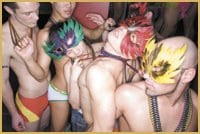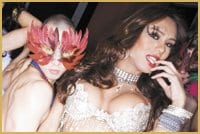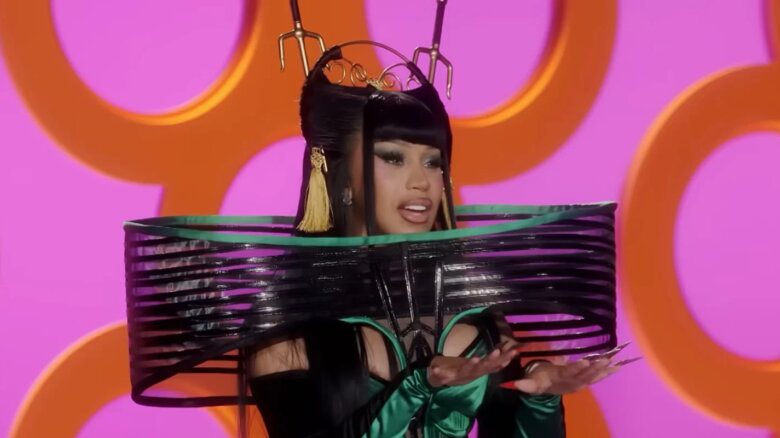
Credit: Sara Race
The dead of winter. A time when we hunker down and hope the next day brings sun. Spring, and with it the promise of summer, remains illusive. Just when we feel the chill has lost its bite, it returns to bitch slap us across the face.
However, with February comes sweet sequin-covered relief. Gay Mardi Gras returns to Vancouver for the third year running. And not another drop below zero too soon.
James Steck, promotions manager for the third annual Davie Village Mardi Gras celebration, knows all too well the need for some hedonistic joy to combat the ills of the season.
“February was always such a boring month in the Village. It’s Mardi Gras season, so why can’t we do that here?”
Taking inspiration from the notorious New Orleans festivities, the Mardi Gras committee promises an event unlike any other. Past events have been a one-day affair. This year, however, the party has evolved into a three-day excuse to have some over-the-top fun. From Feb 21-23, visitors to Davie Village will be able to whip out those sequin-studded clothes, dust off those feathers and join in the festivities.
“We want to encourage people to dress up. Don’t be afraid to come out of your shell. Just have fun with it,” says an enthused Steck.
In the past two years, only specific bars and nightclubs got involved. This year, Mardi Gras revelers will be able to take advantage of discounts at more participating Davie bars, as well as some restaurants and merchants in the Village. All the fun-seeking partygoer needs is to purchase a wristband for a meagre $10, bypass those atrocious lines and be the envy of those with naked wrists.
Each of the participating bars will throw their own themed parties, the celebration culminating in a masked ball on Feb 23 at Celebrities nightclub. PumpJack’s assistant manager Tim Mackrory recognizes how distinctive Mardi Gras is to the city.
“Nowhere else in the city does anything like it. All these businesses band together for a good cause. That itself is unique,” he points out. The staff will be doing their part to create an authentic Mardi Gras experience. However, inquiries into what party people can expect of their risqué costumes was met with a coy, “That is classified.”
Putting a queer spin on Mardi Gras has already proven successful around the globe. The Lower French Quarter of New Orleans attracts thousands who strut their stuff in elaborate costumes of their own making. Bespeckled queens vie for the prestigious Bourbon Street Award.
The celebration has evolved significantly since its turbulent debut in the late 1950s. Back then, queer revelers wanted to parody the heterosexual, aristocratic traditions of the time. In doing so, they found themselves confronted by adversity, resistance and police raids. Perhaps their cause was not helped when they threw their first ball at a children’s private school.
Proving you can’t keep a beaded queen down for too long, the celebrations continued and eventually Gay Mardi Gras came back with a vengeance, attracting media coverage from around the world.
For more than 40 years, the Bourbon Street Awards and the Mardi Gras celebration itself have flourished even amidst controversy, recrimination and opposition. Each year, anywhere between 100,000 to 300,000 revelers make the pilgrimage to the French Quarter. While some scoffed at what they believed to be the epitome of moral decline in American civilization, coverage of the event heightened queer visibility worldwide through the ’60s and ’70s.
Perhaps the largest Gay Mardi Gras takes place in Sydney, Australia. The political ramifications of its origins cannot be ignored. With the objective of raising the visibility of the queer community in the land Down Under, the festival has come far from its tattered roots.
Thirty years ago, 2000 people marched behind a truck with a small PA system down Oxford St to Hyde Park only to be met with public resistance and a degree of police violence. But the Mardi Gras parade returned the following year.
Eventually parliament repealed the legislation that made the arrests justifiable, and a new act ensured citizens no longer needed a permit to have a demonstration. That first queer Mardi Gras parade turned out to be a milestone for civil liberties that stretched even beyond the gay community.
Of course, not everything was sunshine and sequins for the organizers and supporters. Even as the festival grew in popularity, they still faced incredible opposition. The 1985 parade was endangered when the head of Australia’s AIDS task force appealed to the gay community to be responsible and cancel the celebration. A moral crusader known as the Reverend Fred Nile also wished to put an end to the event. He would pray for rain to come and turned out to denounce the revelry. Ironically, this worked to the disadvantage of his cause. Supporters of Gay Mardi Gras, incensed by his convictions, came out in full force. They matched his disapproval with a brave bitchery of their own. Audiences doubled every year until 1984 when 50,000 came out to cut loose. Since then, the celebration has moved into the mainstream and attendance has reached the hundreds of thousands.
What makes Vancouver’s Gay Mardi Gras unique is that it is a party for the sake of having a party. Joan-E, consummate performer and hostess of the participating Majestic Lounge, sees little need for the event to become political. The Pride parade is a celebration of a struggle; for some people, it’s a protest, she notes.
“For some people, it’s a very emotional thing that marks the end of a struggle,” she adds. “I would hate to see Mardi Gras become too politicized. We don’t need to do a Mardi Gras march. I would like it to stay as a celebration”.
Gayvan.com president Angus Praught only sees the benefit of continuing a Vancouver tradition. “It’s always a good idea to get people into the Village and create excitement.”
Through a growing reputation and word of mouth, Gay Mardi Gras attracts tourists to an area not afraid to party in this frosty season. The past two events have even been catching the eye of equally fun-starved American tourists.
Jim Deva of Little Sister’s sees Gay Mardi Gras as “a night of adult activity” and should be identified as clearly as that.
“Keep your children at home and let the adults have a good time. Be a little risqué and a little over the top. Let’s make it a truly gay event,” he says. “It’s an idea that took off very quickly which means it is probably something our community is ready for.”
Perhaps the greatest challenge the festival may face is the weather. Will we want to venture out into what could be a rainy night?
Deva says the queer community will hardly be daunted by whatever Mother Nature throws our way.
“We are hearty folks to begin with. We don’t have to haul our asses to Puerto Vallarta to have a good time. We can do it right here. It might be raining and it won’t be 10 to 15 above, so we’re going to have to brand [the festival] for our own climate and our own people.”
Drag queen Joan-E knows it will take more than the threat of rain to dampen community spirit.
“We’re a pretty inventive group and can usually rally behind a good old party. I think it’s nice to present something like this because this weather can be depressing for a lot of people. As opposed to having an “It’s Raining, It’s Pouring” party, why not have a “Let’s Get Hot, Take Off Our Clothes and Wear Beads” party?”
So how to prepare for this madcap frivolity?
The trick is simply to let your inhibitions take a few days off. Strap on a glittery thong if it suits you.
Think big. Think outrageous. Drench yourself in boas and beads.
Traditional Mardi Gras costumes run the gamut. You could even choose to be a Venetian sorceress, if only for a night or two. Channel the arts-and-crafts skills you picked up at camp and conjure a feathered mask.
Steck, who has seen his share of outlandish wardrobes, is amazed at how involved attendees can get.
“It is great to see the work that people put into their costumes. Seeing everyone get together, it is almost like a second Pride. We now have a Pride in the summer and a Pride in the winter. At the end of the day, we also get to raise money for a good cause”. One hundred percent of the proceeds from the sale of wristbands benefit The LGTB Centre on Bute. Last year, the event raised $8,000. This year the committee hopes to reach $20,000.
The Mardi Gras committee is already envisioning future Mardi Gras and speculating on how they might look.
“I’d love to see a parade happen,” Steck muses. “I would love to see Davie Street shut down and have everyone dressed up in ball gowns and all that crazy stuff. The community just needs a reason to party. We’re just giving them another excuse”.

 Why you can trust Xtra
Why you can trust Xtra


